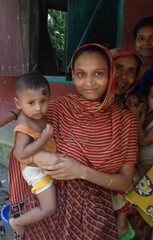The University of California, San Diego has a development economist who has worked extensively in the field of microfinance and is highly critical of its empirical benefits. However, in Bangladesh I find myself surrounded by organizations like Grameen Bank and BRAC that really believe in microfinance as a development tool. Ever since I visited BERDO’s community-based rehabilitation groups, I find myself thinking about microfinance from different angles.
On one hand, I can hear my professor saying that the impact of microfinance on client welfare is still not clear and that it does not have a transformative effect on people’s lives. He argues that loans are often used for consumption rather than investment and that few clients really climb the ladder of credit to start larger businesses. On the other hand, if you spend any time in Bangladesh you can understand why it was the birthplace of microfinance. The Bangladeshi people are hard workers, but with an estimated population of between 142 and 164 million, there are simply not enough resources to go around. Microfinance provides a mechanism for reaching some of the most marginalized communities.
The Grameen Bank Project started its first micro-credit program in Jobra, Bangladesh in 1976 with the goal of extending banking facilities to poor women and men while eliminating the exploitation of the poor by money lenders. Today microcredit has become a hot topic among development researchers and practitioners and many point to situations where microcredit has strayed from its original purpose. For example, a 2007 Businessweek article details how Compartamos (let’s share in Spanish) charged its clients annual interest rates in excess of 100% in some cases and went from a nonprofit organization to a for-profit bank that provided an excellent return for its investors. http://www.businessweek.com/magazine/content/07_52/b4064045919628.htm
So where do I stand on microfinance? I agree with my professor that microfinance is not the solution to every development problem and that the movement needs to focus more on savings. However, when I make a field visit I am more focused on the woman’s face that lights up when she tells me about purchasing a cow for her family than the hard statistics. BERDO provides microcredit at a rate of 12.5% and has been generous in extending grace periods for repayments during natural disasters like the typhoon that swept through Bangladesh in 2007. I do not think that BERDO’s microfinance program would pass a rigorous empirical evaluation, but I do think that it is adding value to communities and allowing people to think beyond tomorrow to what the future could hold, something that I believe has inherent value.
More about my professor at the University of California, San Diego: http://irps.ucsd.edu/faculty/faculty-directory/craig-mcintosh.htm
More about Grameen Bank: http://www.grameen-info.org
One of my favorite websites for clarifying microfinance rates and fees: http://www.mftransparency.org
Posted By Amanda Lasik
Posted Jul 21st, 2011


